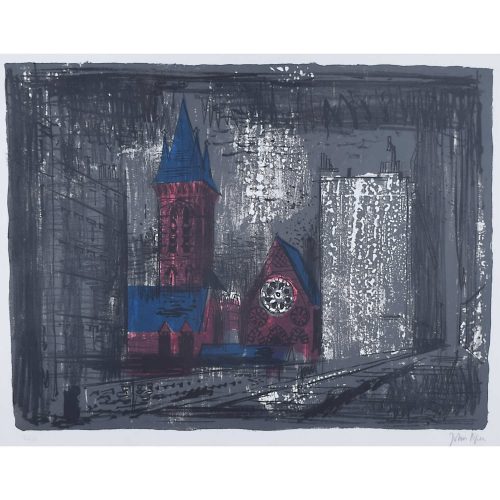-
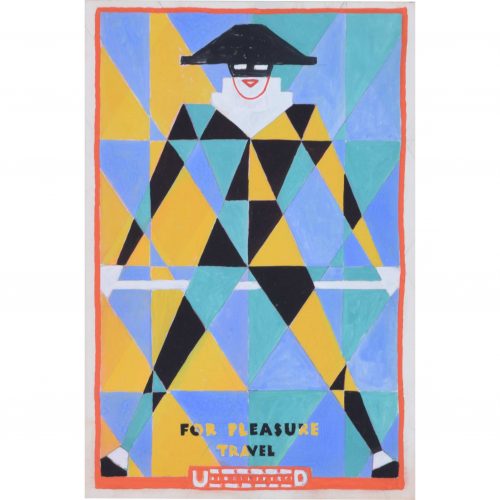
Gerald Mac Spink (flourished 1920 - 1940)
For Pleasure, Travel by Underground (c. 1930)
Gouache 26 x 18 cm Original design for a London Transport poster. Framed. A dynamic Art Deco poster design by Mac Spink. A boldly-coloured harlequin figure encourages travel via the London Underground. Spink was a skilled artist and designer who produced a series of posters in the inter-war period for companies including the London Underground, Southern Railways, LNER, Hawker Engineering, and British Steel. He won a prize in 1933 from the Imperial Institute for his poster artwork. He also worked as an aeronautical engineer in Kingston-on-Thames for Hawker Engineering; his greatest achievement was the creation of the 'Squanderbug', a 500cc racing car which he built in 1947, and which races even to this day. Provenance: the artist's estate. Condition: good; a few small scuffs to gouache, as visible in photographs. Handsomely framed. If you’d like to know more, please email info@manningfineart.co.uk or call us on 07929 749056. -
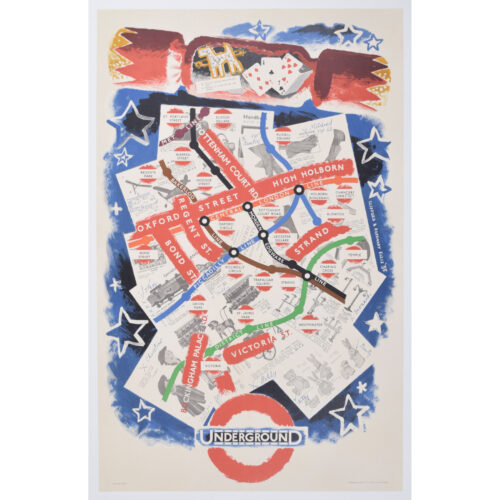
Clifford and Rosemary Ellis
London Underground Map (1935)
Original vintage poster 103 x 64 cm Signed in the plate 'Clifford & Rosemary Ellis '35". Printed by Waterlow & Sons Ltd for London Transport. Provenance: the artists' studio. This marvellous original vintage poster was designed for London Transport and encourages shoppers to use the Tube to do their Christmas shopping. The map of London's streets of shops, including Oxford Street, Regent Street, and Bond Street, are set on the background of a Christmas shopping list and various items to be purchased. The cross-section of a Christmas cracker at the top of the poster includes the joke: 'Why is a railway timetable like life?' - 'Because it is full of ups and downs. London Transport was the forerunner of London Underground. During the 1930s London Transport commissioned over forty posters a year from well-known artists such as Laura Knight, CRW Nevinson, Edward Wadsworth, Eric Ravilious, Paul Nash, Graham Sutherland, and Edward McKnight Kauffer – a bold policy that did much to popularise avant-garde artistic styles that stemmed from Cubism, Futurism and Abstraction. Condition: very good; backed to linen. If you are interested, please email info@manningfineart.co.uk or call us on 07929 749056. Click here for other original vintage London Transport posters. -
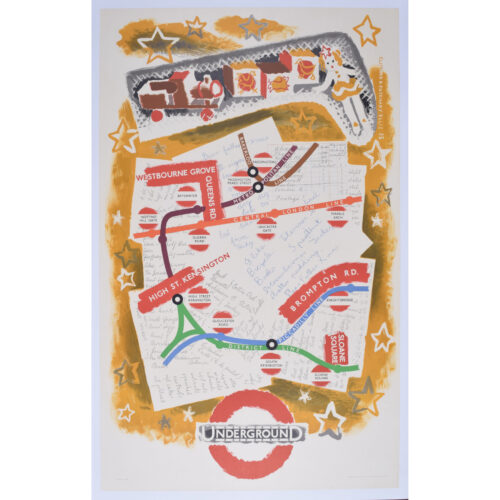
Clifford and Rosemary Ellis
London Underground Map (1935)
Original vintage poster 103 x 64 cm Signed in the plate 'Clifford & Rosemary Ellis '35". Printed by Waterlow & Sons Ltd for London Transport. Provenance: the artists' studio. This marvellous original vintage poster was designed for London Transport and encourages shoppers to use the Tube to do their Christmas shopping. The map of London's streets of shops, including High Street Kensington, Westbourne Grove, and the Brompton Road, are set on the background of Christmas wishlists and shopping lists. The cross-section of a Christmas stocking at the top of the poster includes a doll and a toy train amongst other stocking fillers. London Transport was the forerunner of London Underground. During the 1930s London Transport commissioned over forty posters a year from well-known artists such as Laura Knight, CRW Nevinson, Edward Wadsworth, Eric Ravilious, Paul Nash, Graham Sutherland, and Edward McKnight Kauffer – a bold policy that did much to popularise avant-garde artistic styles that stemmed from Cubism, Futurism and Abstraction. Condition: very good; backed to linen. If you are interested, please email info@manningfineart.co.uk or call us on 07929 749056. Click here for other original vintage London Transport posters. -
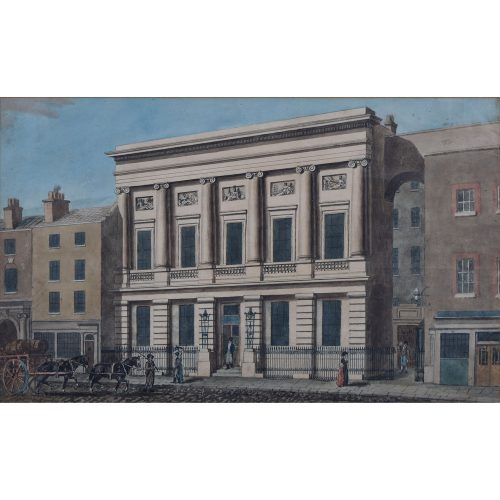
Schnebbelie (Robert Blemmell, circa 1785-1849) The Commercial Sale Rooms, Mincing Lane, City of London (c. 1814)
Pencil, pen, ink & watercolour 25 x 42 cm Captioned to mount, "Used as the Custom House after the Original House was Burnt from 1814 to 1817". With engraving of the same image pasted to reverse of frame, published by James Whittle & Richard H. Laurie, Jan. 16th, 1815. Schnebbelie was an English painter and illustrator who produced many views of London. His father, Jacob, was a confectioner who was subsequently employed by the Society of Antiquaries of London as a draughtsman, but who died at the age of 31. Following his death, Robert took up his father's profession. Between 1803 and 1821 he exhibited at the Royal Academy; Engravings based on his drawings were widely published - most notably in Robert Wilkinson's Londina Illustrata (1808-1825), David Hughson's Description of London and the Gentleman's Magazine. His works are in the collections inter alia of the Museum of London, the Guildhall Art Gallery and the Huntington Museum of Art in West Virginia. If you are interested email info@manningfineart.co.uk or call us on 07929 749056. -
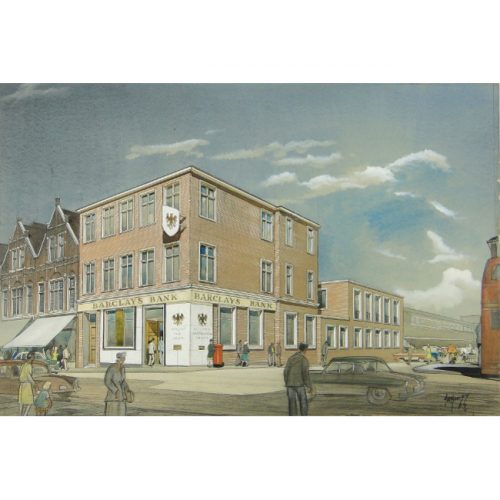
John Dean Monroe Harvey (1895-1978)
A design for Barclays Bank, Walthamstow (1964)
Signed and dated ‘J D M Harvey 64.’ Gouache on paper. A very fine architectural perspective by Harvey with his customary distinctive clouds and elegant people. The scheme was built, but the ground floor has since been rebuilt in a rather less satisfactory fashion. 41 x 60 cm (16 x 23 inches) For biographical details and more works by JDM Harvey, please click here. If you are interested email info@manningfineart.co.uk or call us on 07929 749056. -
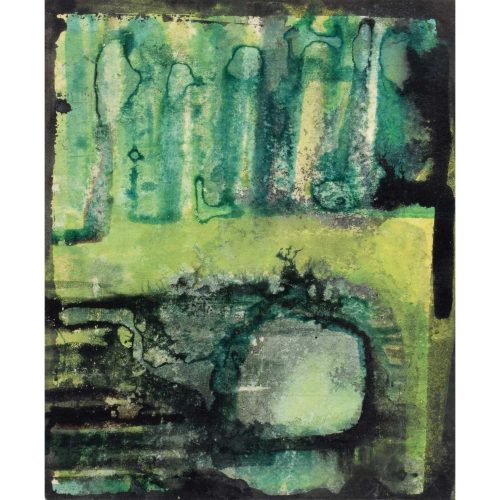
John Piper (1903-1992)
Study for the Piper Building mural
Gouache 14.5x11.5cm Provenance: P Manzareli (who built the fibreglass murals for Piper), gift from the artist; Milne & Moller Fine Art; Katharine House Gallery; private collection, Scotland. This study is a fascinating part of London's architectural history. The Piper Building is a mid-century architectural icon in Fulham. Built in the 1950s as 'Watson House', it was a laboratory complex for the North Thames Gas Board and has an innovative concrete structure. Piper was commissioned to produce the murals surrounding the building. The Gas Board moved out in the mid 1980s. Scheduled for demolition in the 1990s, the building was instead converted into seventy apartments and renamed the Piper Building. With double-height ceilings, the apartments were sold as shells, and purchasers were free to commission their own architects and builders. Condition: Generally excellent; framed. For other works by the artist and biographical details, click here. If you are interested email info@manningfineart.co.uk or call us on 07929 749056. -
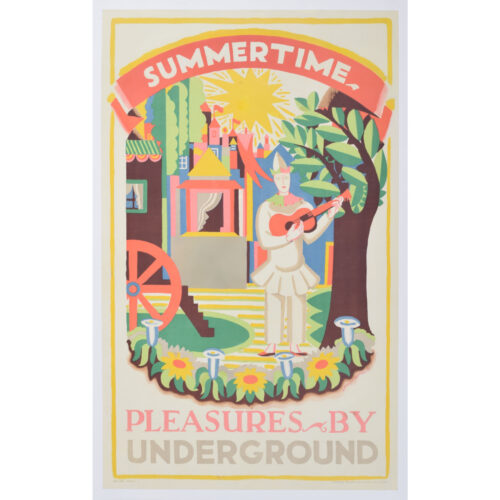
Edward McKnight Kauffer (1890 - 1954)
Summertime - Pleasures by Underground (1925)
Original vintage poster 101 x 63 cm Signed and dated in plate. Issued by the Underground Electric Railways Co. of London, Ltd., 1925. This is one of a series of posters designed by Edward McKnight Kauffer bearing the legend 'Summertime - Pleasures by Underground'. A doleful Pierrot figure (a lovestruck clown character from commedia dell'arte) plays a lute before a castle with streaming pennants; a country caravan, daffodils, leafy trees and a bright yellow sun complete the scene. Other posters from the series include similar traditional folk characters, such as a Jack-in-the-green. Edward McKnight Kauffer was an American artist and graphic designer who lived for much of his life in the United Kingdom. He is mainly known for his work in poster design, but was also active as a painter, book illustrator and theatre designer. He studied art at the California School of Design from 1910 to 1912 and then at the Académie Moderne in Paris until 1914 (via a six month stint at the Art Institute of Chicago). He moved to London upon the start of the First World War and produced 140 poster for London Underground and London Transport. He created posters for Shell Oil, the Great Western Railway and other commercial clients, and also illustrated books and book covers. Later he also became interested in textiles, interior design, and theatrical design. He returned to New York City in 1940 and began designing posters for American Airlines (his primary client until his death) in 1947 .In 1952 he designed the book jacket for Ralph Ellison's novel Invisible Man - arguably Kauffer's most famous work. Condition: generally very good; backed to linen. If you are interested, please email info@manningfineart.co.uk or call us on 07929 749056. Click here for other original vintage London Transport posters. -
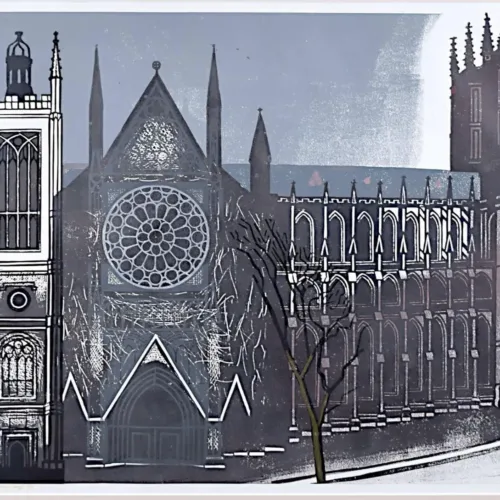
Edward Bawden (1903 - 1989)
Westminster Abbey (1966)
Linocut print 52 x 68 cm (92 x 107 framed) Signed, titled, inscribed 'Artist's Proof' and numbered 42/75 (Bawden inscribed 'Artist's Proof on all of his prints). Bawden's view of Westminster Abbey, cast in shades of blue, grey, and black.Edward Bawden was an English painter, illustrator and graphic artist, known for his prints, book covers, posters, and garden metalwork furniture. Bawden taught at the Royal College of Art, where he had been a student, worked as a commercial artist, and served as a war artist in World War II. He illustrated several books and painted various public murals, and his work and career are often associated with that of his contemporary, Eric Ravilious.Condition: generally very good. Inscription slightly faded. If you are interested, please email info@manningfineart.co.uk or call us on 07929 749056. Click here for other work by the artist. -
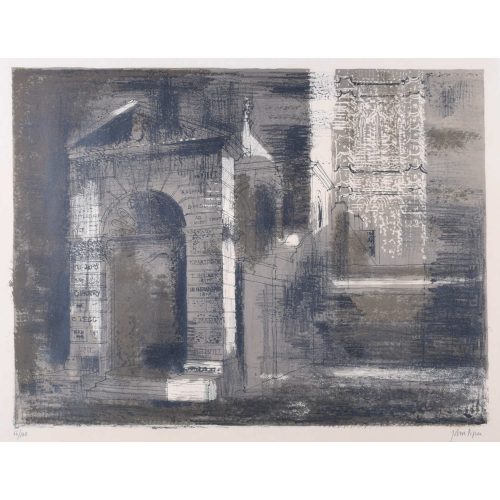
John Piper (1903-1992)
Westminster School I (1961)
49 x 63 cm Signed lower right and numbered 66/100 lower left in pencil. Piper's skilled and characterful rendering of Westminster School's gateway, sometimes known as Burlington's Arch. The historic entrance to the school dates from 1734 and is carved with the names of former pupils. John Piper CH was an English painter, printmaker, and designer of stained-glass windows. His work often focused on the British landscape, especially churches and monuments, and included tapestry designs, book jackets, screen-prints, photography, fabrics and ceramics. Condition: Generally very good, gentle even toning to the paper. If you’d like to know more, please email info@manningfineart.co.uk or call us on 07929 749056. -
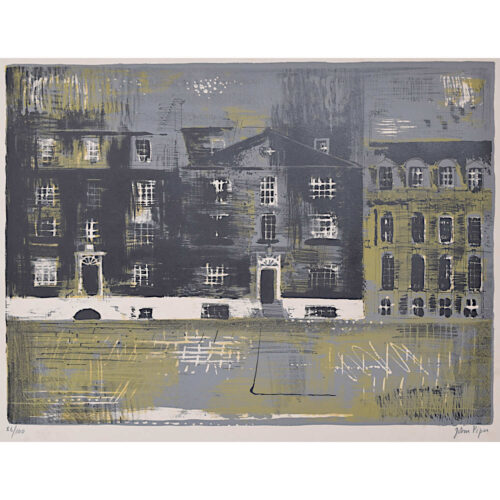
John Piper (1903-1992)
Westminster School II (1961)
42 x 59 cm Signed lower right and numbered 86/100 lower left in pencil. Piper’s second view of Westminster School; both views were commissioned by the school in 1981. Here he depicts Grant's House, with College on the far left and Rigaud’s House on the right. The view is serene and silent, set against a night sky the colour of stone, mimicking the buildings below. John Piper CH was an English painter, printmaker, and designer of stained-glass windows. His work often focused on the British landscape, especially churches and monuments, and included tapestry designs, book jackets, screen-prints, photography, fabrics and ceramics. Condition: generally very good; a little age toning. A few spots to margins. If you’d like to know more, please email info@manningfineart.co.uk or call us on 07929 749056. Click here for other works by John Piper CH. -
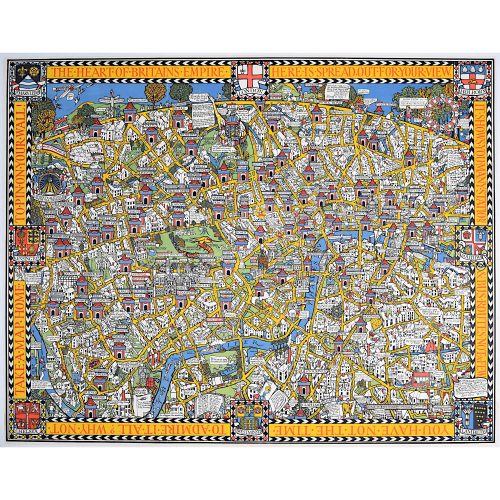
Macdonald (Max) Gill (1884-1947) Wonderground Map of London (c. 1924, after 1914 original edition)
Lithographic poster 75x94cm In the present work, in the top left-hand corner it reads 'On to Wembley' making reference to the British Empire Exhibition of 1924. Gill's original 1914 poster was hugely popular and reprinted with updates to feature topical events. Born in Brighton, Max Gill was the second son in a family of thirteen children; his elder brother was Eric Gill, the typographer and sculptor. Both Gills exhibited significant talent at a young age. Max Gill’s first map was made for a school map-drawing project following which he entered maps into competitions in boys’ magazines. In 1903 he moved to London as assistant to the ecclesiastical architects Sir Charles Nicholson and Hubert Corlette. By 1908 he had started his own architectural practice, but in 1909 Sir Edwin Lutyens commissioned Gill to paint a “wind dial” map for Nashdom, a large house in Buckinghamshire. The wind dial was set over the fireplace and attached to a weather vane on the roof, allowing the occupant to know the direction of the wind from the comfort of the house. He produced seven further wind dials including for Lutyens’s Lindisfarne Castle and for the Allhusen Room at Trinity College, Cambridge. Although he continued to practice as an architect, Frank Pick commissioned him to create seven pictorial maps for the Underground, the first being the famous 1913 ‘Wonderground Map of London Town.’ In 1917 he joined the Imperial War Graves Commission’s headstone design committee, designing the typeface and regimental badges. Gill’s memorials for the fallen in the First World War include for Balliol and Worcester Colleges and Christ Church in Oxford. During the 1920s and 30s Gill undertook many commercial commissions for advertising materials. The Empire Marketing Board and Shell-Mex as well as further maps for the Underground. He designed in 1922 the first diagrammatic map of the Underground which provided the foundation for Beck’s more famous map. By the 1930s his major works were murals. Those of the Arctic and Antarctic on the ceilings of the Scott Polar Research Institute in Cambridge are beautiful, but the most impressive is the map of the North Atlantic in the first-class dining room of the Queen Mary (maiden voyage: 1936, now moored at Long Beach, California). During the Second World War he created a series of propaganda posters for the Ministry of Information. -
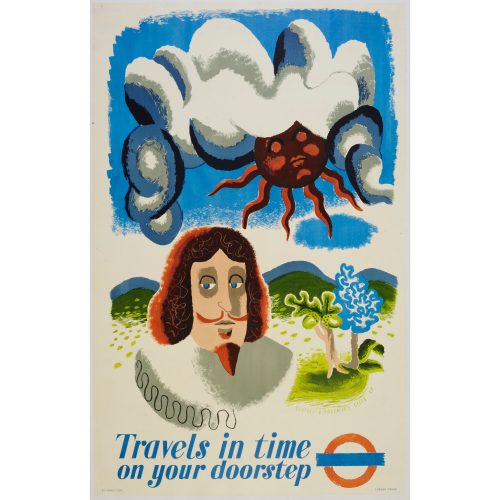
Clifford and Rosemary Ellis
Travels in Time on your Doorstep
Lithographic poster for London Transport (1937) 101 x 63.5 cm Printed by Curwen Press Provenance: the family of the artist, by descent. Condition: A- backed to linen, pin holes to corners. Click here for biographical details and other works by the artist. If you are interested email info@manningfineart.co.uk or call us on 07929 749056. -
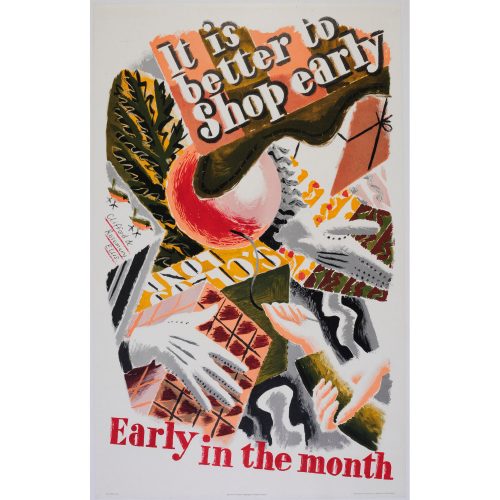
Clifford and Rosemary Ellis
Shop Early (1935)
Lithographic poster for London Transport 101 x 63.5 cm Printed by Waterlow & Sons Ltd For the artist’s biographical details and for other works by the artist available for sale please click here. If you are interested email info@manningfineart.co.uk or call us on 07929 749056. -
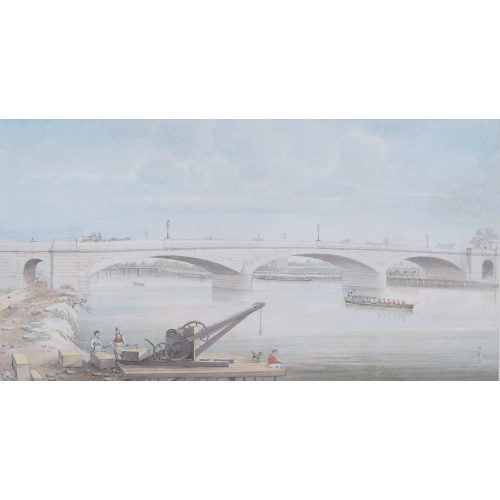
Gideon Yates
View on The Thames with Staines Bridge
25 x 48 cm Watercolour Charmingly signed lower left, on the side of the stone c.1830 Little is known of the life of Yates. Even his date of death is disputed with some sources putting it at 1837. What is known is that he spent most of his working life in London, producing many detailed views of The Thames such as this one. His style is very distinctive, and this large and impressive view of London Bridge is a typical view. He is thought to have lived in Lancaster in 1811, and to have travelled widely throughout Britain and the Continent. His works are in public collections including the Victoria and Albert Museum. UK Government Art Collection item 6701 is another view of The Thames by Yates. Click here for other paintings by Yates. If you are interested email info@manningfineart.co.uk or call us on 07929 749056. -

Albert Walter Moore (1874 – 1965)
Design for 30 Fenchurch Street (1915)
Pencil and watercolour on paper 38.1 x 62 cm Signed and inscribed ‘Albert W Moore FRIBA Architect, 112 Fenchurch St, March 1915’. Provenance: Sotheby’s lot 166, 25 June 1981. A design for a fine building on the Plantation House site (the site was cleared in 2005 for a new building, '30 Fenchurch Street'). The architectural drawing is rendered carefully in pencil, with blue, yellow, and brown washes adding colour and depth to the picture. Moore was articled to George Hubbard, and the two became partners in 1898. He studied at the West London School of Art and was a member of the Architectural Association. Condition: very good; some losses to frame. -
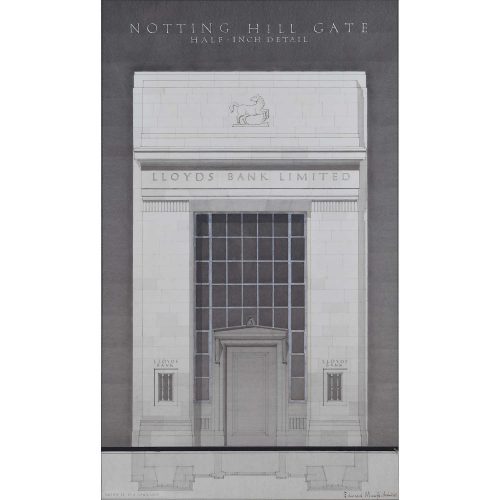
Sir Edward Brantwood Maufe KBE, R.A, F.R.I.B.A. (1882-1974)
Lloyds Bank, Notting Hill Gate (c.1930)
Ink and wash 60 x 37 cm In original white-painted frame. Signed 'Edward Maufe, Architect' lower right; also signed 'Drawn by H A Townsend'. This bank, designed by Maufe, still stands; contrary to the flourishes of the architectural design, however, it was executed in a slightly more restrained style. Sadly, a gratuitously unattractive modern front now defaces the front of the original bank building. Maufe is probably most famous for his Guildford Cathedral, the Air Forces Memorial, and his work for the Imperial War Graves Commission, for which he received his knighthood in 1954. He served a five-year apprenticeship under William Pite and then attended St John’s College, Oxford as an undergraduate. He then studied Design at the Architectural Association. His architecture is notable for its strong arts and crafts influence; this likely arose from his having lived in The Red House, Bexleyheath, which Philip Webb designed for the most famous of the Arts and Crafts designers: William Morris. If you are interested, please email info@manningfineart.co.uk or call us on 07929 749056. -
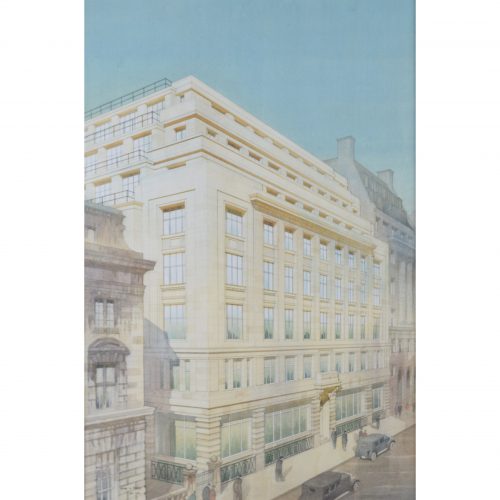
Cyril A. Farey
Design for an Art Deco office building, (1932)
Signed ‘Cyril A Farey Del 1932’ Pencil and watercolour 23 x 16 in A glorious and large drawing of an as-yet unidentified art deco building. This picture is classic Farey, with the reflections in the foreground and the bright blue sky. Biographical details and other works by Cyril Farey can be found here. If you are interested email info@manningfineart.co.uk or call us on 07929 749056. -
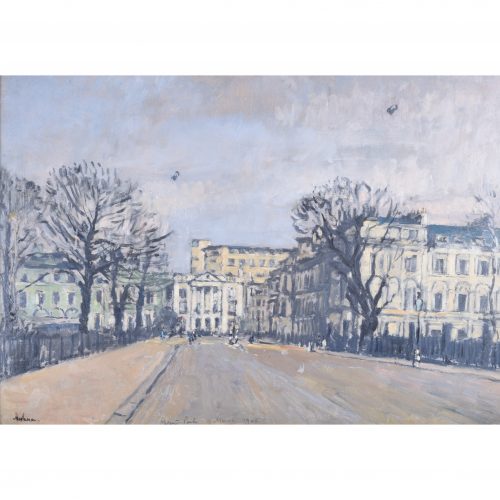
Paul Ayshford Methuen (1886 - 1974)
Barrage Balloons, Regents Park, 9 March 1940
Oil on board 36 x 52 cm Signed lower left and titled and dated lower centre. Lord Methuen's oil painting of Regent's Park on a winter's day, with barrage balloons above. Barrage balloons were set up - stationed at an altitude of around 4,000 ft - as a barrier to enemy aircraft. The steel cables used to tether the balloons would take an enemy aeroplane out of the sky if it were to hit the cable. The UK had thousands of them, filled partly with hydrogen and operated largely by women, to protect significant towns, cities, and military installations. These strange blobs floated over the country, just asking to be captured by artists. Methuen had rejoined his regiment (serving as a Captain) in 1939 but was likely stationed in London for a while, when he might have had the opportunity to capture this scene. When Methuen painted the scene in 1940, Britain was still in the stage of the phoney war. The Battle of Britain did not commence until 10 July, and the Blitz not until 7 September - but Britain's defences were ready. Barrage balloons were important all the way through the War: they defended London against the V2 missiles; they defended the D-Day invasion fleet; and they protected the invasion army for months. Indeed, it was said that the vast amount of material brought into the UK from the States prior to D-Day would have caused Britain to sink under the sea, were it not for the huge number of barrage balloons holding the country up... Condition: excellent. Recently revarnished. If you’d like to know more, please email info@manningfineart.co.uk or call us on 07929 749056. -
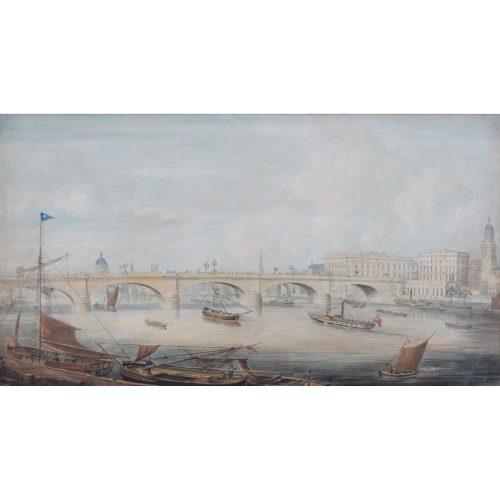
Gideon Yates (?1790-?1840)
1831 View on The Thames with London Bridge from the East Side showing Fishmonger's Hall, The Church of St Magnus the Martyr and St. Paul's Cathedral.
c.1831 29x54cm Watercolour unsigned Provenance: The Parker Gallery LIttle is known of the life of Yates. Even his date of death is disputed with some sources putting it at 1837. What is known is that he spent most of his working life in London, producing many detailed views of The Thames such as this one. His style is very distinctive, and this large and impressive view of London Bridge is a typical view. He is thought to have lived in Lancaster in 1811, and to have travelled widely throughout Britain and the Continent. His works are in public collections including the Victoria and Albert Museum. In this view, Thames barges are in the foreground with their distinctive brown sails. A steamship proceeds along the middle of The Thames. The first steamboat patented was in 1729, by John Allen an English physician. However it was not until 1783 that the first steam-powered ship, "Pyroscaphe," was demonstrated on the River Saône. By 1788 John Fitch in Philadelphia was operating a commercial service along the Delaware River were built in the United States. The first sea-going steamboat was the "Experiment" built by Richard Wright in 1813; by this point river services were becoming well established although it was not until 1815 that The Thames acquired its first successful services with "Margery" and "Thames" arriving from the Clyde where they had been in service for some years. Margate and Gravesend were the main destinations. The steamboat in this view is a paddlesteamer, with two side wheels. At the north end of London Bridge (on the far side from the viewer) is Fishmongers' Hall, St Magnus the Martyr Church is visible on the near side of the bridge, and St Paul's Cathedral is visible beyond. UK Government Art Collection item 6701 is another view of The Thames by Yates, also from The Parker Gallery. If you are interested email info@manningfineart.co.uk or call us on 07929 749056. -
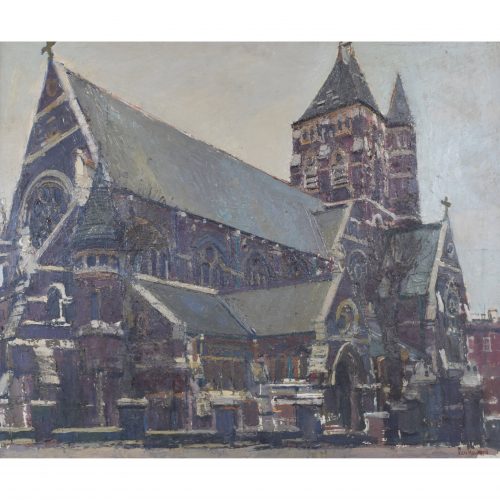
Ken Howard RA (1932 - 2022)
Hampstead Church (St Stephen's Church, Rosslyn Hill)
Oil on board 75 x 91 cm Ken Howard's magnificent view of St Stephen's Church, Hampstead. The artist's rich, deep colour palette and use of impasto underline the neo-gothic style of the church. Howard died in Hampstead and painted several views of the area and its architecture. St Stephen's was designed in the Neo Gothic style by Samuel Sanders Teulon and he considered it the best of the 114 churches he designed, calling it his "mighty church". The building is no longer a church, but wedding ceremonies still take place there; it was made a Grade I listed building in 1974. Kenneth Howard OBE RA was a British artist and painter. He was President of the New English Art Club from 1998 to 2003. He studied at the Hornsey College of Art and the Royal College of Art. In 1958 he won a British Council Scholarship to Florence, and in 1973 and 1978 he was the Official War Artist to Northern Ireland, and 1973 - 80 worked in various locations, including Hong Kong, Cyprus and Canada with the British Army. In 1983 he was elected an Associate of the Royal Academy (ARA). In 1998 he became President of the New English Art Club, a post he held until 2003. In 1991 he was elected a Royal Academician (RA). Howard was given his OBE in 2010. Condition: very good. If you’d like to know more, please email info@manningfineart.co.uk or call us on 07929 749056. -
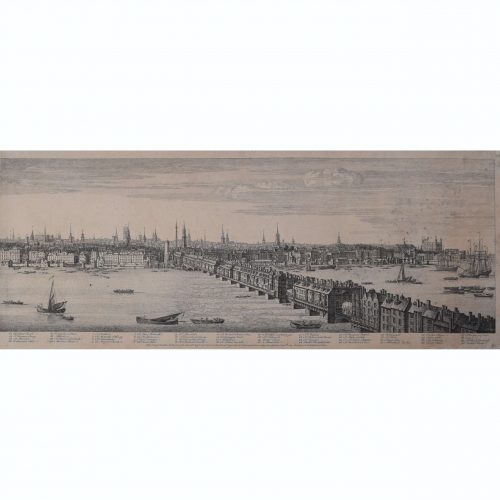
Samuel Buck (1696-1779) & Nathaniel Buck (active 1724-59) Panorama of the River Thames from Westminster Bridge to London Bridge
Published September 1749 30x404 cm Engraving Scroll down for further description. If you are interested email info@manningfineart.co.uk or call us on 07929 749056. -
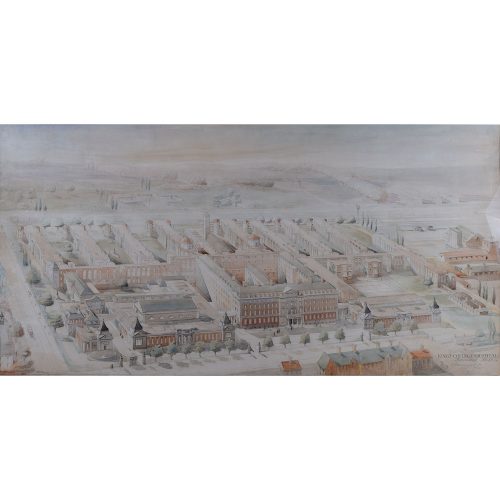
William Alfred Pite (1860-1949)
King`s College Hospital, Denmark Hill general bird`s-eye view (1913)
Initialled H.M.F., signed and titled by William A. Pite F.R.I.B.A. (1860-1949), lower right, on board support with R.I.B.A. `Exhibition of Contemporary British Architecture` label, and architect`s label both mounted on verso Watercolour over pencil 46 x 92cm (26.25 x 18 inches)

